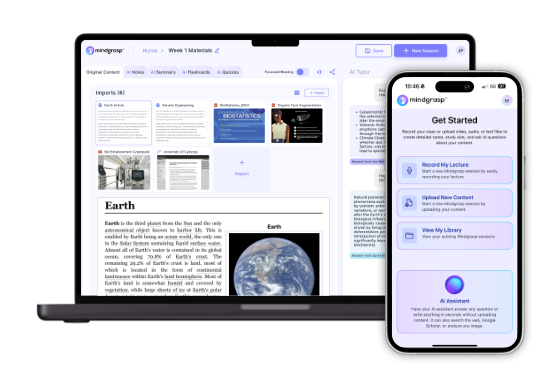
To cram for a medical exam, we'll need to be strategic.
First, identify the highest-yield topics (the 20% that covers 80% of questions). Use active recall techniques like flashcards and practice questions instead of passive re-reading.
Break complex concepts into visual diagrams or flowcharts. Study in 25-minute chunks with 5-minute breaks to maintain focus. Don't sacrifice sleep—your brain needs it to consolidate information.
The right approach makes even last-minute studying surprisingly effective.
Btw if you need to turn lecture slides into a study guide, check out our Study Guide Creator from Slides which is perfect for last-minute medical exam cramming! Just upload your slides and get a custom study guide made in seconds.
Why cramming for medical feels harder than other classes
While cramming for any exam can be stressful, medical exams take this challenge to a whole new level. Most medical students face the formidable task of mastering 70+ lectures in just days—that's like trying to drink from a fire hose!
The material isn't just voluminous; it's complex and interconnected. Unlike history or literature where memorization might work, medicine demands understanding how systems work together. You can't just memorize the symptoms of heart failure—you need to understand why they occur.
Even the best study techniques fall short when cramming medicine because:
- The material requires clinical application, not just facts
- Concepts span multiple disciplines simultaneously
- The high stakes create extra pressure that blocks retention
Your brain simply isn't designed to process this much complex information overnight!
Boost Your GPA Faster with Mindgrasp
Instantly turn your class notes into smart summaries, flashcards, and quizzes—study less, learn more, and ace your exams.
Try it FreeStep 1: Determine what to study (Prioritize high-impact topics)
Now that we recognize why cramming for medical exams is so challenging, let's tackle the problem head-on! When time is limited, you need to be strategic about what you study.
Remember the 80/20 rule—roughly 80% of exam questions come from just 20% of the material! To identify these high-yield topics:
- Check past exams and study guides
- Focus on what your professors emphasized (bolded terms, diagrams they lingered on)
- Use resources like First Aid that already condense the important stuff
- Look at what topics have the most practice questions
When creating your study schedule, allocate more time to topics you struggle with, but make sure all high-yield material gets covered.
This targeted approach helps you maximize your limited study time while minimizing panic!
Step 2: Gather your medical materials and make a quick plan
The three key elements to successful medical exam cramming are your materials, space, and plan.
First, collect high-yield study materials like First Aid and UWorld question banks—these resources cut through the fluff and focus on what matters most.
Next, organize everything by subject or system. This makes it way easier to tackle one topic at a time without feeling overwhelmed. Remember those concepts your professors emphasized? Flag them—they're exam gold!
Finally, map out your study time. Break down the days you have left and assign specific subjects to each block.
We recommend setting daily goals you can actually achieve (be realistic about what you can cover in a day). This approach guarantees you'll review everything important before exam day arrives.
Step 3: Use active recall to study medical (Don’t just re-read)
Ditch those passive study habits right now! Simply re-reading your medical textbooks won't cut it when you're in crunch mode. Active recall is your secret weapon – it can boost your memory retention by up to 50% compared to just reviewing notes.
Here's how to make it work:
- Create flashcards for key terms, diseases, and treatments
- Quiz yourself with practice questions that mimic exam format
- Explain complex concepts to your roommate (or stuffed animal!)
- Try the Feynman Technique: explain topics in super simple terms
We've found that combining active recall with spaced repetition works wonders. Test yourself, identify weak spots, then hit those areas again.
Your brain forms stronger connections when you actively pull information from memory – it's like a mental workout before the big game!
Step 4: Break down complex medical processes with diagrams
Medical processes can feel like dense jungles of information, but diagrams are your machete!
We've found that transforming complex topics into visual formats makes them stick in your brain much better than text alone.
Try these diagram strategies:
- Create flowcharts for step-by-step processes like glycolysis
- Use concept maps to connect related systems (how does the cardiovascular system impact the respiratory one?)
- Add color coding to highlight different components
- Draw your own simple sketches—even if they're not artistic masterpieces!
When you draw something yourself, you're fundamentally teaching your brain twice—once while creating the diagram and again when you review it.
Your hands help your head remember those tricky pathways and relationships that examiners love to test!
Step 5: Leverage AI study tools like Mindgrasp AI for medical
While traditional studying methods have their place, modern cramming demands modern solutions—that's where AI tools like Mindgrasp AI come into play!
Try Mindgrasp for Free!
Experience an easier, faster way to boost your GPA. Sign up now to try Mindgrasp AI for free and see how AI-powered learning transforms your study routine.
Try it FreeWe've found these smart platforms can transform your medical education experience in several ways:
Mindgrasp AI summarizes those dense medical textbooks into bite-sized chunks you can actually digest (no more drowning in pathophysiology details!).
It also personalizes your study plan based on what you already know, saving precious cramming time.
The interactive quizzes adapt to your knowledge gaps—pretty cool, right?
Plus, it uses clever spaced repetition to help concepts stick in your brain when you're rushing to learn everything.
Need practice questions? It's got tons of those too, covering all the high-yield topics you're most likely to see on exam day.
Step 6: Memorize key terms and definitions with flashcards & mnemonics
Grab those flashcards—they're about to become your best friends in the medical cramming game! We've found that flashcards work wonders for medical terms because they force your brain to actively recall information, not just passively read it.
Try these quick tips:
- Shuffle your cards to mimic random exam questions
- Add visual elements (a simple drawing of the heart for cardiac terms)
- Use digital apps like Anki or Quizlet that space out your repetitions
Don't forget mnemonic devices! Create silly sentences or weird associations—the stranger, the better for remembering.
"On Old Olympus Towering Tops" for cranial nerves, anyone? These memory tricks stick because they transform boring facts into something your brain actually wants to remember.
Step 7: Practice with questions and problems
Now that you've got your flashcards down, it's time to put your knowledge to the real test—practice questions! We can't stress this enough: tackle at least 20-30 questions during each study session. This isn't just about testing yourself; it's about training your brain to recognize question patterns, especially for exams like the USMLE Step.
Here's why practice questions work wonders:
- They reveal weak spots you didn't know you had
- They mimic the actual exam format (no surprises on test day!)
- They strengthen your recall through active learning
Don't just check if you got answers right—review why wrong answers are wrong too. This step is essential!
Use question banks specifically designed for medical exams, and incorporate them regularly into your study routine.
Step 8: Take short breaks and look after yourself
Your mind needs rest just as much as it needs practice questions! We recommend using the Pomodoro Method—study intensely for 25 minutes, then take a 5-minute break. These strategic breaks aren't wasted time; they're when your brain actually processes what you've learned!
During breaks, try:
- Taking a quick walk (boosts your brain power!)
- Drinking water (dehydration ruins concentration)
- Stretching or doing jumping jacks
- Looking away from screens
Self-care isn't optional during cram sessions. Make sure you're eating properly, staying hydrated, and—this is essential—getting enough sleep. Your brain consolidates memories during sleep, so pulling an all-nighter might actually hurt your chances of remembering those tricky medical terms!
Remember: even short breaks make a big difference in your studying stamina.
Cramming for medical in 1 Day, 3 Days, or 1 Week
We've all been in that panic mode when a medical exam is just around the corner.
Let's explore how to make the most of your remaining study time—whether you've got a week, three days, or just 24 hours left.
We'll tailor our cramming strategies to fit your timeframe, focusing on high-yield topics for one-day sessions and building more thorough approaches when you've got a full week to prepare.
Cramming for medical with one week left
When you're down to just one week before your medical exam, it's time to shift into high gear—but don't panic! This is still enough time to make significant progress with the right approach.
Start by identifying high-yield topics—focus on that critical 20% that covers most exam questions. Break your study sessions into manageable chunks using the Pomodoro Technique (25 minutes of focus, 5-minute breaks). This helps maintain concentration and improves information recall.
Don't just passively read your notes! Engage actively with the material through practice questions, flashcards, and teaching concepts to classmates. These techniques cement knowledge far better than re-reading.
Remember to revisit difficult topics every few days—this spaced repetition approach strengthens memory pathways.
With one week left, you've got this—just be strategic about how you use your time!
Cramming for medical with three days left
Three days before your medical exam represents a critical countdown phase—less time but still enough to make a meaningful impact!
At this stage, we need to be strategic about our medical study approach.
Let's focus on the highest-yield content—the 20% that covers 80% of exam questions.
Break your study into Pomodoro sessions (25 minutes of work, 5-minute breaks) to stay fresh and avoid burnout.
Ditch passive reading! Instead:
- Test yourself with practice questions
- Use flashcards for rapid review
- Create a tight schedule with specific subjects in each time slot
- Join quick study groups to discuss tricky concepts
Cramming for medical with one day left (24 hours)
With just 24 hours remaining before your exam, it's time to enter emergency mode—but don't panic! Your strategy now must maximize every minute of time available.
Ditch passive learning completely—no more reading textbooks cover-to-cover. Instead:
- Focus only on high-yield materials that cover the critical 20% of content likely to represent 80% of exam questions
- Use mini-spaced repetition by reviewing key flashcards every 3-4 hours
- Tackle your toughest subjects first while your mind is fresh
- Implement strict Pomodoro sessions (25 minutes studying, 5 minutes break)
- Teach complex concepts aloud to yourself (or your cat!)
Common mistakes to avoid when cramming and how to fix them
Despite your best efforts to study consistently throughout the semester, cramming for a medical exam might become inevitable—but that doesn't mean you should fall into common traps that make your efforts less effective.
We've seen students make the same mistakes repeatedly: relying on passive rereading, cramming everything at once, and neglecting a proper study schedule.
Instead, try these fixes:
- Replace passive reviewing with active techniques like practice questions
- Break study sessions into 25-30 minute chunks with short breaks
- Focus on high-yield concepts first—not obscure details
- Create a structured study schedule, even for your cramming day
- Don't sacrifice sleep—your brain needs rest to consolidate information
Final Takeaways on medical cram studying
Effective cramming isn't ideal, but it's a reality many medical students face at some point in their education. When time is tight, remember the 80/20 rule—focus on high-yield materials that likely cover most exam questions. We've all been there!
Break your study sessions into 30-minute chunks with short breaks—your brain will thank you.
Don't just passively read notes; use active strategies like:
- Teaching concepts to imaginary students (or real ones!)
- Tackling practice questions from past exams
- Using spaced repetition to cement key facts
Download Mindgrasp from the App Store
Access Mindgrasp at your desk for in-depth research and writing projects, or use the mobile version to easily access your content on-the-go or record live lectures.
Download the iOS App
